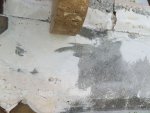I have a sample of travertine remodeling coping. its nice but it goes close to an inch over the bond beam of my pool (I think bond beam is the word). We like the way the coping hangs over. it looks good and adds some depth but I am worried about it cracking apart in the future because the deck will obviously move at a different rate than the pool. I am going to use a high flex mortar but I was wondering if I do not mortar past the bond beam but use the right type of flexible sealer/ adhesive/ caulking would that work?
Is it even something I should worry about?
The old tile was set up to avoid this by using an upside down bullnose at the top which only covered the deck edge
Is it even something I should worry about?
The old tile was set up to avoid this by using an upside down bullnose at the top which only covered the deck edge


